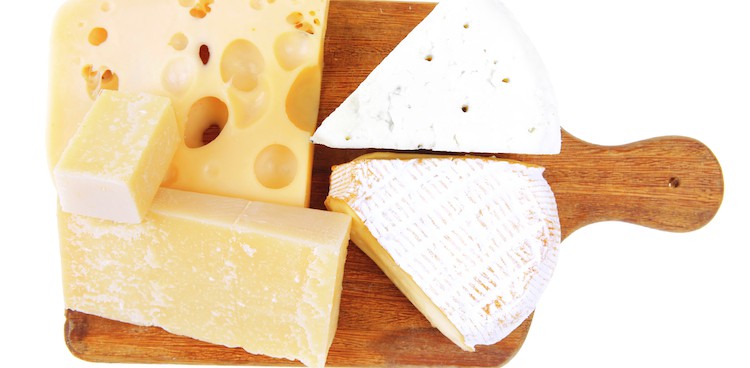
Cheese is a living, changing commodity. It will be different from season to season, year to year, and even day to day. The texture a cheese has when it leaves the maker’s facility may be different from the texture it has after it leaves a cheesemonger’s case. A cheese made from grass-fed summer milk may have a different texture and flavor from that same cheese made with the grain-supplemented milk of winter. We’ve done our best to make these categories specific, but some cheeses always fall between categories. Some will hop from one category to another as they age. We feel that’s OK, especially since cheese itself is an evolution.
SOFT CHEESES
dollopy – Cheese you can scoop up and, with a flick of the wrist, dollop onto something. Not all spoonable cheeses are dollopy. The cheese should not be sticky, gooey, or stretchy. Dollopy cheeses may be firmer when chilled, resembling heavy cream that has been whipped into stiff peaks; when warmed, dollopy cheeses will soften, and may separate eventually. Examples include fromage blanc, ricotta, and mascarpone.
gooey – Cheese that will cling to and coat a spoon (or finger, and definitely your tongue). Gooey cheeses ooze at the slightest chance; cutting open a protective rind or removing them from a container will result in a sticky, oozy puddle. Gooey cheeses tend to become even gooier with age. Examples include Époisses, crescenza stracchino, and Vacherin Mont d’Or.
SEMI-SOFT CHEESES
spreadable – Cheese you can cut with the dullest of butter knives and which at room temperature can be spread on delicate bread without tearing it. While very soft, a spreadable cheese does not readily ooze at room temperature. It may cling to a knife or spoon, but its paste is not sticky. Examples include fresh chèvre, Camembert, and Limburger.
stretchy – Cheese you can stretch with your fingers or that seems like it might bounce if dropped. Unlike gooey cheeses, which can start off slightly firm when young but may age into gooeyness, stretchy cheeses maintain their elasticity and bounce even as they age. Examples include mozzarella, string cheese, cheese curds, and young halloumi.
fudgy – Cheese easily mashed to a paste. Fudgy cheeses will not bounce back when pressed, but will collapse under pressure. However, they are too firm to spread without damage to a cracker. At room temperature the cheese will maintain its shape, but may release drops of moisture. Examples include young block cheddars, most blue-veined cheeses, Monterey Jack, and Muenster.
SEMI-FIRM CHEESES
supple – Cheese that dents when pressed firmly with a finger but which springs back into shape. Unlike mushy cheese, a supple cheese cannot be squished into a paste—although it may break apart if you put enough pressure on it. Supple cheeses are easily bitten or cut, and will not crumble. Examples include fontina, Abondance, Jarlsberg, and young gouda.
crumbly – Cheese that is moist but dense and firm. Crumbly cheeses will break into pieces when squeezed, but will never become soft at room temperature. A crumbly cheese will “weep” as it warms, but maintain its crumbly texture. It may have a bit of spring to it, and can bounce back when pressed, but enough pressure will cause it to break along natural fault lines. A crumbly cheese will never be soft enough to spread. Examples include ricotta salata, aged cotija, and Caerphilly.
FIRM CHEESES
toothsome – Cheese you can sink your teeth into but that is hearty and firm. A bite will leave behind a perfect imprint of your teeth. With a good cheese slicer or knife, you can cut a toothsome cheese into thin slices and it will not break, crumble, or flake apart. Unlike a supple cheese, a long piece of toothsome cheese bent at a 90-degree angle will break, not stretch back into shape. Examples include Comté, Gruyère, and aged block cheddar.
HARD CHEESES
flaky – Cheese that breaks into flakes and shards when you cut it. These cheeses are very firm, and cannot be dented with a finger. When cut with a knife, they will break apart at natural fault lines where the curds bonded together and leave crumbles on the cutting board. These cheeses often have small, crunchy amino acid crystals throughout their paste. Examples include aged gouda, clothbound cheddar, and aged Mimolette.
grating – Cheese that is dry enough to suck the moisture out of your mouth and crumbles when you threaten it with a grater. A grating cheese is so hard that it is difficult to cut and is often served as shards or shredded over a dish. Grating cheeses have such low moisture contents that they are shelf-stable. Frequently they are aged for multiple years. Examples include Parmigiano Reggiano, dry Jack, and Pecorino Romano.



